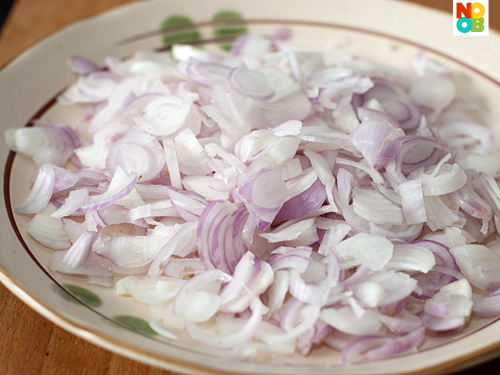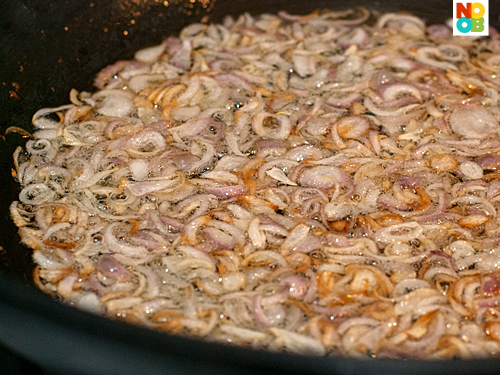Crispy Fried Shallots Oil

Crispy fried shallot oil (葱头油) is one of my favourite condiments which can be topped over almost any dish. I particularly love these fried shallots over plain porridge, fried rice or oyster sauce vegetables. I love them on its own as well – I can eat it as a snack. In my earlier attempts in deep frying the shallots, I burnt them, because I found out that even though deep frying shallots takes considerably longer than making garlic oil, the shallots go from light golden brown to golden brown really quickly. Hence you need to watch the flame very carefully especially during the second half of the cooking.
More Home-made Oil Recipes:
- Garlic Oil Recipe (pictured above)
- Fried Lard Oil Recipe
- Rendered Duck Fat Recipe
- Rendered Chicken Fat Recipe
Check out the step-by-step photo guide below for the various stages of cooking the shallots. Note that the actual timing will depend on the heat of your cooker. Generally, it takes about 12-15 minutes to cook the shallots.

STEP-BY-STEP PHOTOS
Peel shallots and if you rinse them before slicing, dab dry with a kitchen towel first. Slice thinly and uniformly to ensure even cooking.
Heat oil to medium. As you can see in the photo above, there are tiny bubbles which indicate that the oil is starting to be heated. You can add a small piece of shallot to test the heat before adding all of them.
When oil is heated, add sliced shallots. This is look of the shallots after adding them to the the oil for 1 minute. They are dancing and bubbling mildly in the oil so I turn up the heat up very slightly.
At the 10 minute mark of cooking, you can see parts of the shallots browning. At this point in time, you have to give the shallots your fullest attention (no multi-tasking) because they can become burnt quite quickly from this point on.
At this point in time (when the shallots start to brown), I add 1/2 tsp salt. The salt helps the shallots to be crispy and also adds flavour.
At this point in time, more than half the shallots have turned golden brown. This is where I turned off the stove – the shallots will continue for a few more minutes in the hot oil even with the stove heat off, until all the shallots turn a lovely golden brown.
When the fried shallots are cooked, separate the shallots from the oil using a slotted ladle. Blot out excess oil by draining the shallots on kitchen paper towels or tempura paper. Store the fried shallots in an airtight container in the fridge.
Run the shallot oil through a fine sieve to get particle-free oil. This oil has been infused with the wonderful aroma of shallots. Keep it covered with lid and use it in your cooking and stir-fries – it adds a great flavour to your cooking.





















I love fried shallots on top of noodles and soups, but I never considered making them myself – and it’s so easy to! Great tutorial. :)
Dear Wiffy,
Hello again – thanks for all the recent recipes!! Love the new look of the site and also noticed more step by step recipes which makes it really easy for us!
One comment for the shallot – I used to fry them too but always get them burnt as the fire was either too strong or not enough oil or the shallots not well spread. So my sis taught me another method – MICROWAVE – it’s really so much easier and less messy i thought(no oil splurts)- I will use medium high for the shallots that are just immersed with enough oil to skim the top for about 8 – 10 min – but u probably need to trail and error as it is dependent on the mircowave heat. Just need to ensure it does not get burn and when it has turn a nice golden brown, take it out immediately as it will continue to cook.
Hi Samnatha!! Thanks for your sweet words … and hehe glad someone noticed the new look :D
oh my I never thought of using microwave for making fried shallots. Coz I was afraid the oil may be over heated. But sounds like something worth learning! Thanks for sharing :)
Dear Wiffy,
Hello again – thanks for all the recent recipes!! Love the new look of the site and also noticed more step by step recipes which makes it really easy for us!
One comment for the shallot – I used to fry them too but always get them burnt as the fire was either too strong or not enough oil or the shallots not well spread. So my sis taught me another method – MICROWAVE – it’s really so much easier and less messy i thought(no oil splurts)- I will use medium high for the shallots that are just immersed with enough oil to skim the top for about 8 – 10 min – but u probably need to trail and error as it is dependent on the mircowave heat. Just need to ensure it does not get burn and when it has turn a nice golden brown, take it out immediately as it will continue to cook.
I can almost smell the shallots. So yummy! This goes well with everything. so yummy!!
I leave the shallots on a newspaper to dry because of the oil. It was crispy at first but after a while (~1hr), it becomes soggy and not crispy.
What should I do instead? Store it in the container immediately when there is still oil within the shallots?
Thanks!
Hi, can I refrigerate the shallots for more than a week? I kept my last batch for like a month and kept using it as long as it’s not moldy. Do you think it’s still safe for consumption?
Hi Tammi, I should think as long as they are not moldy or taste different, it should be quite safe. I’ve refrigerated the shallots for about 1 week, it doesn’t really last beyond that timeframe since I like snacking on them :P
Shallot oil is a healthier choice to replace animal oil like lard, yet without compromising taste and flavour. Thanks for sharining ;D
How if I use onions instead of shallots? Will it turn out the same? I really miss those fried shallots… It’s hard to get shallots in the UK.
Thank you for this post. I was looking for a recipe for fried shallots online and ended up finding and using yours. Awesome pictures and very clear instructions. Thanks!!
In Indonesia we have a special kind of shallot for make fried shallots. It will stay crispy for months if kept in airtight container. Common shallots is crispy just after fried then becomes soggy. Onion will not crispy.
Pingback: Pork Porridge Recipe (猪肉粥)